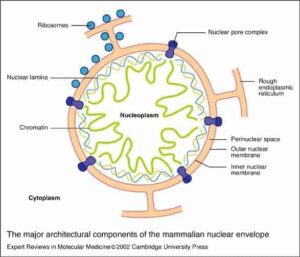Nucleus:-
The nucleus is a double membrane-bound protoplasmic organelles which contain the genetic information for control cellular metabolism and transmission to the next offspring.
The nucleus was first discovered in orchid root cells by Robert brown called it Areda.
The study of the nucleus is called as Karyology.
Flemming gave name chromatin.
It is absent in RBC, Sieve tube of angiosperm.
Nucleoplasmic Index: –
There is a specific ratio between nucleus and volume of cytoplasm which is called as Nucleoplasmic index (NP) or Karyoplasmic index that is expressed as Hertwig Equation –
NP = Vn/ Vc– Vn
Where –
Vn = Volume of nucleus
Vn = Volume of cell
Number:-
Commonly cells possess single nucleus that is called uninucleate cells. Paramecium caudatum is binuclear. Paramecium Aurelia is trinucleate. Cells having many nuclei are called multinucleate cells example Mucor, Vancheria (Algae) syncytium of animal and striated muscle cells.
Shape of Nucleus:-
It is commonly round but it is bilobed in eosinophil, trilobed in basophils and multilobed in neutrophils. It is kidney shaped in macrophages, horseshoe shaped in vorticella.
Chemical composition:-
DNA= 9-12%
Basic protein = 15%
Enzyme, acid protein & neutral protein =65%
RNA =5%
Lipids = 3%
Minerals Ca2+, mg2+, k+, Na+ = traces
Phosphorus is present in RNA and DNA.

- Nuclear Membrane: – it is also called karyotheca or nuclear membrane. The Nuclear Membrane is formed by the ER at the end of mitosis in telophase. Like another membrane nuclear membrane is made of phospholipid bilayer, which is permeable to small non-polar molecules, another molecule unable to diffuse. It is 70-80Å thick. Space between outer and inner membrane is called perinuclear space. Inner membrane there is a fibrous protein net called fibrous lamina connected with peripheral heterochromatin is present. Lamina looks like honeycomb layer.
- Nuclear Pore: – Nuclear membrane has many pores. Nuclear pore formed by the nucleoporin having 9nm pore size. Pore size is increased by Ran protein. The diameter of pore is 300- 1000Å. Nuclear pore structure is octagonal. The nuclear pore may have a diaphragm, septum or plug of electron-dense material. Nuclear envelop contains pore complex that is made by annulus (bleb) and nuclear pore.
- Nuclear Lamina: – Nuclear lamina composed of protein lamins. In addition to structural support nuclear lamina serve to site of chromatin attachment.
- Nucleoplasm: – It is also known as nuclear sap or karyolymph or karyoplasm. It is discovered by It is homogenous, semi-liquid, granular colloidal and clear jelly-like matrix resembling with cytoplasm. It is acidophilic in nature. Nucleoplasm contains DNA polymerase, RNA polymerase, inducer, receptor in RNA etc.
- Chromatin: – it is a Fibrillar complex which is found in nucleus. It is named chromatin because of its ability to get stained with certain basic dyes like acetocarmine, hematoxylene. There are two types of chromatin –
- Euchromatin: – It is genetically active. It is lightly stained. It has less histone, more acidic protein are present in certain part of nucleus. It is transcriptionally active it shows normal cycle of replication and condensation, crossing over and gene activation.
- Heterochromatin: – It is active. It is dark stained chromatin. It is condensed and granular part of chromatin which shows late replication, higher degree of condensation and little crossing over and gene activity. It contains more histone and less acidic protein.
- Nucleolus: – it is discovered by Fontana and the name was given by Bowman. It is round and naked structure that is attached to chromatin at specific point called nucleolar organize region or NOR. NOR is formed of heterochromatin. Cell actively engaged in protein synthesis have large nucleolus. For example oocytes, neurons etc. there are the parts of nucleolus –
- Fibrous part: – Central part of nucleolus composed of fibers called nucleonema. Nucleonema mainly composed of DNA and proteins.
- Granular part: – Peripheral part of nucleolus composed of granules (r-RNA + protein) which represents maturing ribosomes.
- Amorphous matrix or pars amorpha: – A proteinaceous matrix which contains both fibers and granules. Ribosomal protein is synthesized in cytoplasm.
- Chromatin part: – It is made of DNA. In nucleolus, there are two types of chromatin that are intranucleolar chromatin and perinucleolar chromatin.
- The function of Nucleolus: – Three types of functions performs by nucleolus that is synthesis of protein, and synthesis of ribosomal RNA and transfer of genetic information from the nucleus to the cytoplasm. Nucleolus is known as ribosomal factory, ribosomal protein synthesized in the cytoplasm.
- Chemical Composition of Nucleolus: – The nucleolus consists of 85% Protein, 10% r-RNA, and 5% of DNA.
Reference
Wikipedia
BSER books
NCERT books
Molecular Biology of the Cell-Alberts
Cell and Molecular Biology Concepts and Experiments.Geraldkarp
Cell Biology, Genetics, Molecular Biology, Evolution and Ecology by Verma, Agarwal




